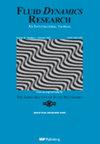基于稀疏卷积神经网络的超音速翼型流场计算有效估计
IF 1.3
4区 工程技术
Q3 MECHANICS
引用次数: 0
摘要
本文提出了一种基于稀疏卷积神经网络(SCNNs)和Bézier生成对抗性网络(GAN)的翼型超音速流场建模创新方法,其中(1)建立SCNN模型以从空间稀疏的几何形状端到端预测翼型周围的超音速可压缩物理流场,以及(2)利用训练的Bézier GAN生成大量光滑翼型以及表示翼型的潜在代码。翼型几何形状的空间稀疏位置使用符号距离函数(SDF)表示。特别地,将潜在代码与SDF矩阵和马赫数合并,形成SCNN模型的输入,有效地使SCNN模型对不同的流动条件具有更鲁棒的几何适应性。与常规卷积神经网络相比,最重要的贡献是SCNN引入了稀疏卷积运算来处理空间稀疏输入矩阵,特别是在执行卷积时只关注具有流信息的局部区域,最终节省了内存使用,提高了网络对流区域的关注度。此外,测试结果表明,SCNN模型可以更准确地预测超音速流场,平均绝对误差低于5%,并节省40%的图形处理单元内存。这些结果表明,所提出的SCNN模型能够捕捉超音速流场的冲击波特征,提高了学习效率和计算效率。本文章由计算机程序翻译,如有差异,请以英文原文为准。
Computationally effective estimation of supersonic flow field around airfoils using sparse convolutional neural network
This work proposes an innovative approach for supersonic flow field modeling around airfoils based on sparse convolutional neural networks (SCNNs) and Bézier generative adversarial network (GAN), where (1) the SCNN model is built to end-to-end predict supersonic compressible physical flow fields around airfoils from spatially-sparse geometries and (2) the trained Bézier-GAN is utilized to generate plenty of smooth airfoils as well as the latent codes representing airfoils. The spatially-sparse positions of airfoil geometry are represented using signed distance function (SDF). Particularly, the latent codes are merged with the SDF matrix and the Mach number to form the input of the SCNN model, effectively making the SCNN model possess more robust geometric adaptability to different flow conditions. The most significant contribution compared to the regular convolutional neural network is that SCNN introduces sparse convolutional operations to process spatially-sparse input matrix, specifically, which only focuses on the local area with flow information when performing convolution, eventually saving memory usage and improving the network’s attention on the flow area. Further, the testing results show that the SCNN model can more accurately predict supersonic flow fields with a mean absolute error lower than 5% and save 40% of graphics processing unit memory. These results indicate that the proposed SCNN model can capture the shock wave features of supersonic flow fields and improve learning efficiency and computing efficiency.
求助全文
通过发布文献求助,成功后即可免费获取论文全文。
去求助
来源期刊

Fluid Dynamics Research
物理-力学
CiteScore
2.90
自引率
6.70%
发文量
37
审稿时长
5 months
期刊介绍:
Fluid Dynamics Research publishes original and creative works in all fields of fluid dynamics. The scope includes theoretical, numerical and experimental studies that contribute to the fundamental understanding and/or application of fluid phenomena.
 求助内容:
求助内容: 应助结果提醒方式:
应助结果提醒方式:


